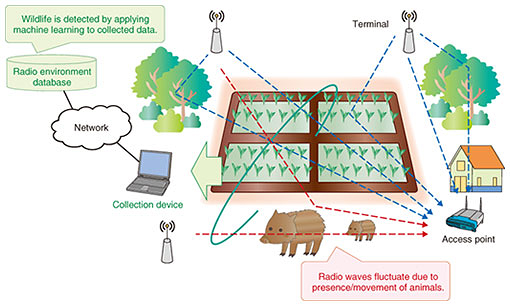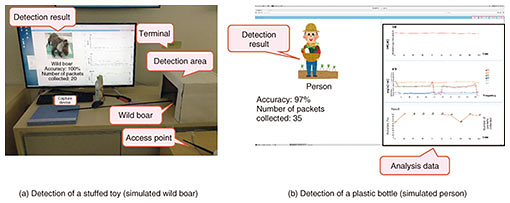 |
|||||||
|
|
|||||||
|
Feature Articles: Network Technology for Digital Society of the Future—Research and Development of Competitive Network Infrastructure Technologies Vol. 17, No. 6, pp. 45–48, June 2019. https://doi.org/10.53829/ntr201906fa13 Wildlife Detection System Using Wireless LAN SignalsAbstractThe NTT Group considers the primary industry of agriculture an important field and is promoting development of innovative technologies that integrate agriculture with information and communication technology. This article introduces initiatives related to a wildlife detection system that are part of this work. The system can accurately detect wildlife that enters agricultural land over a wide area, using only fluctuations in wireless local area network radio signals. Keywords: wireless LAN, sensing, machine learning 1. IntroductionDamage to agricultural produce by wildlife totals around 20 billion yen per year in Japan, with damage from wild boar and deer accounting for approximately 80% of this (Fig. 1). This damage also contributes to secondary damage such as a declining desire to continue farming, and unutilized arable land, resulting in deeper social issues than are represented by these numbers. Many institutions are actively studying measures to counter such wildlife damage using information and communication technology to detect intrusions, prevent intrusions, capture, or chase away the wildlife. The NTT laboratories are focusing on sensing technologies for detecting intrusions using radio waves.
2. Trends in sensing technologies using radio wavesRadio waves are used as a communication medium by mobile terminals such as smartphones and are widely used in mobile communications and wireless local area network (LAN) systems. They are also used for non-communications applications such as sensing, microwave ovens, GPS (Global Positioning System), and wireless power transmission, making them essential for everyday life. Sensing technologies have attracted particular attention recently, and application domains have been expanding, from detecting people and animals (a domain already in use) to object and behavior recognition (a new domain). Sensing technologies utilizing radio waves can be categorized by whether the object being detected has a radio device or not. We refer to the latter as device-free sensing. Generally, device-free sensing is done using various types of radio waves such as microwaves, millimeter waves, infrared rays, and visible light. In this study we focus on microwaves, which are very good compared to other radio waves in terms of detection range, detection of obstructed objects, and detection at night (Table 1). Moreover, if wireless LAN microwave frequencies are used, some existing wireless LAN devices can be reused, reducing the cost of deploying the system.
3. Wildlife detection system using wireless LAN radio wavesFor the proposed system, an IEEE (Institute of Electrical and Electronics Engineers) 802.11ac [1] wireless LAN access point and several terminals are deployed in the sensing area, and fluctuations in the radio waves between them are analyzed to detect wildlife in the area (Fig. 2). Specifically, a separate collection device deployed in the area collects the radio packets for Channel State Information (CSI)* notifications, which are periodically exchanged between the access point and terminals and are necessary for transmission beam forming. The data are collected into a database on the network, and machine learning is applied to detect wildlife [2]. The proposed system enables CSI to be collected easily, which could previously only be done using specialized equipment, and it enables existing wireless LAN systems to be repurposed, greatly reducing the cost of deployment. A dynamic demonstration of the system was conducted at the NTT R&D Forum 2018 Autumn, in which a wild boar stuffed animal and a plastic bottle representing a person were recognized, demonstrating the feasibility of the system (Fig. 3).
4. Future prospectsMany of the visitors to the NTT R&D Forum 2018 Autumn were troubled by the agricultural damage caused by wildlife, so we intend to use the proposed system to establish technology to counter wildlife damage and also to expand the range of applications beyond wildlife, to detecting intrusions by people and objects as well. References
|
|||||||









